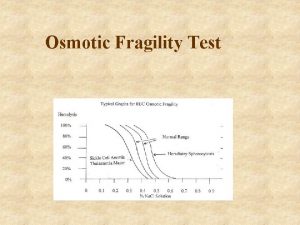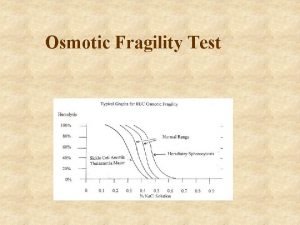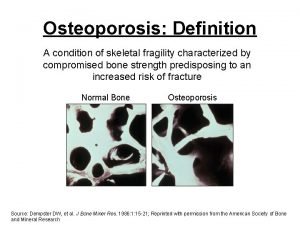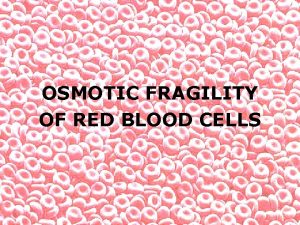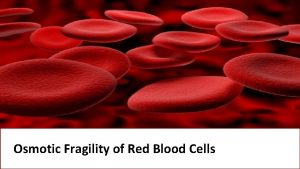Osmotic Fragility Test Osmotic fragility Definition Osmotic fragility









- Slides: 9

Osmotic Fragility Test

Osmotic fragility • Definition: – Osmotic fragility is a test to measures red blood cell (RBC) resistance to hemolysis when exposed to a series of increasingly dilute saline solutions. – The sooner hemolysis occurs, the greater the osmotic fragility of the cells. • Factors affect the osmotic fragility: 1. Cell membrane permeability. 2. Surface-to – volume ratio.

Why the Test is performed? • This test is performed to detect thalassemia and hereditary spherocytosis. • Hereditary spherocytosis is a common disorder in which red blood cells are defective because of their round, balllike (spherical) shape. These cells are more fragile than normal. • Spherical cells are said to have increased osmotic fragility because they are less likely to expand break open in salter water than normal red blood cells (which are indented or curved inward on both sides).

Why the Test is performed? • The test does not distinguish between spherocytes in HS and in acquired autoimmune hemolytic anemia.

• Osmotic fragility decreased in: – Thalassemia. – Iron deficiency anemia. – Sickle cell anaemia. • Osmotic fragility of red cells increased in: – Hereditary spherocytosis. – Acquired spherocytosis.

Osmotic Fragility Test • Purpose: 1 - To aid diagnosis of hereditary spherocytosis & Thalassemia. 2 - To supplement a stained cell examination to detect morphologic RBC abnormalities. • Material: – Specimen: whole blood – Collection Medium: Na Heparin tube or Lithium Heparin tube. – Minimum: 5 ml whole blood. – Rejection Criteria: Hemolyzed specimen. – Methodology: Spectrophotometer.

Procedure 1 - We will do this dilution: Test tube 1 2 3 1%Nacl(ml) D. W. (ml) Final conc. (%) 10. 0 8. 5 7. 5 0. 0 1. 5 2. 5 1. 00 0. 85 0. 75 4 5 6 7 8 9 10 11 12 13 14 6. 5 6. 0 5. 5 5. 0 4. 5 4. 0 3. 5 3. 0 2. 0 1. 0 0. 0 3. 5 4. 0 5. 50 6. 0 7. 0 8. 0 9. 0 10. 0 0. 65 0. 60 0. 55 0. 50 0. 45 0. 40 0. 35 0. 30 0. 20 0. 10 0. 00

Procedure 2 - Then we divide every volume in 2 tubes so now we get 28 tubes. 3 - Add 50 micron of whole blood to every tube. 5 - Well mixing by using the vortex. 6 - Centrifuge for 5 minutes at 2500 rpm. 7 - Now we will measure the absorbance in the tubes by using spectrophotometer (540 nm). 8 - calculate the % of hemolysis.

Result: • % of hemolysis = (Abs of tube / Abs of tube 14) * 100% • Normal Range: – Hemolysis begins 0. 45% and complete 0. 35%

